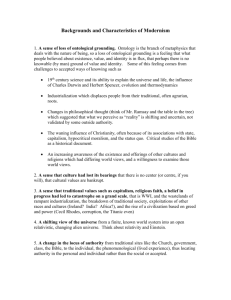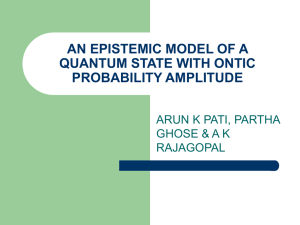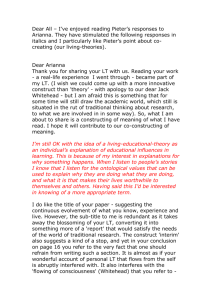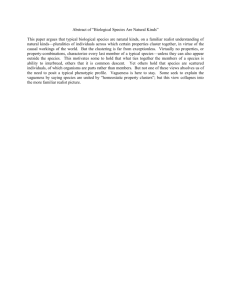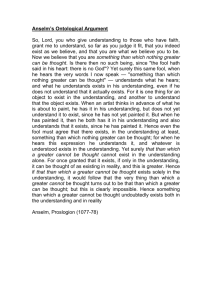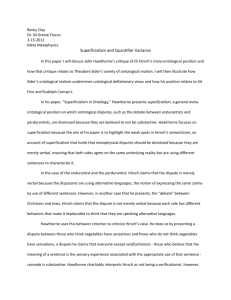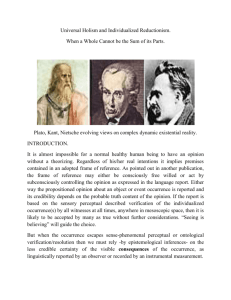Veberian Scorekeeping Matjaž Potrč Although Veber started with
advertisement
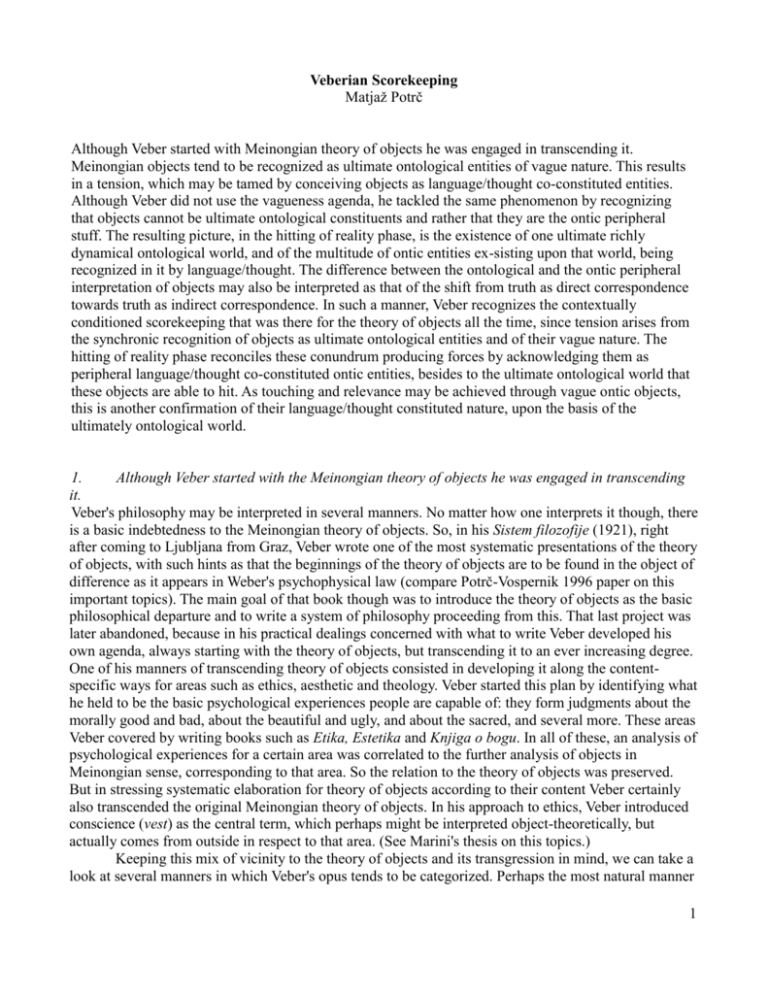
Veberian Scorekeeping Matjaž Potrč Although Veber started with Meinongian theory of objects he was engaged in transcending it. Meinongian objects tend to be recognized as ultimate ontological entities of vague nature. This results in a tension, which may be tamed by conceiving objects as language/thought co-constituted entities. Although Veber did not use the vagueness agenda, he tackled the same phenomenon by recognizing that objects cannot be ultimate ontological constituents and rather that they are the ontic peripheral stuff. The resulting picture, in the hitting of reality phase, is the existence of one ultimate richly dynamical ontological world, and of the multitude of ontic entities ex-sisting upon that world, being recognized in it by language/thought. The difference between the ontological and the ontic peripheral interpretation of objects may also be interpreted as that of the shift from truth as direct correspondence towards truth as indirect correspondence. In such a manner, Veber recognizes the contextually conditioned scorekeeping that was there for the theory of objects all the time, since tension arises from the synchronic recognition of objects as ultimate ontological entities and of their vague nature. The hitting of reality phase reconciles these conundrum producing forces by acknowledging them as peripheral language/thought co-constituted ontic entities, besides to the ultimate ontological world that these objects are able to hit. As touching and relevance may be achieved through vague ontic objects, this is another confirmation of their language/thought constituted nature, upon the basis of the ultimately ontological world. 1. Although Veber started with the Meinongian theory of objects he was engaged in transcending it. Veber's philosophy may be interpreted in several manners. No matter how one interprets it though, there is a basic indebtedness to the Meinongian theory of objects. So, in his Sistem filozofije (1921), right after coming to Ljubljana from Graz, Veber wrote one of the most systematic presentations of the theory of objects, with such hints as that the beginnings of the theory of objects are to be found in the object of difference as it appears in Weber's psychophysical law (compare Potrč-Vospernik 1996 paper on this important topics). The main goal of that book though was to introduce the theory of objects as the basic philosophical departure and to write a system of philosophy proceeding from this. That last project was later abandoned, because in his practical dealings concerned with what to write Veber developed his own agenda, always starting with the theory of objects, but transcending it to an ever increasing degree. One of his manners of transcending theory of objects consisted in developing it along the contentspecific ways for areas such as ethics, aesthetic and theology. Veber started this plan by identifying what he held to be the basic psychological experiences people are capable of: they form judgments about the morally good and bad, about the beautiful and ugly, and about the sacred, and several more. These areas Veber covered by writing books such as Etika, Estetika and Knjiga o bogu. In all of these, an analysis of psychological experiences for a certain area was correlated to the further analysis of objects in Meinongian sense, corresponding to that area. So the relation to the theory of objects was preserved. But in stressing systematic elaboration for theory of objects according to their content Veber certainly also transcended the original Meinongian theory of objects. In his approach to ethics, Veber introduced conscience (vest) as the central term, which perhaps might be interpreted object-theoretically, but actually comes from outside in respect to that area. (See Marini's thesis on this topics.) Keeping this mix of vicinity to the theory of objects and its transgression in mind, we can take a look at several manners in which Veber's opus tends to be categorized. Perhaps the most natural manner 1 of dividing Veber's work recognizes three phases. The first of these phases may be characterized as object-theoretical, and it would then encompass all the work that we have mentioned up till this point. The second phase would be personalistic, and it would be represented by the book Filozofija. The third phase would be that of hitting the reality, as elaborated in the book Vprašanje stvarnosti. This already shows that not only the first of these phases transcends the strict object-theoretical approach, but that this is even more the case for the shift towards person and then to reality. Some people recognize additional phases in respect to the just mentioned three. So Trstenjak distinguishes five phases (Vom Gegenstand zum Sein), and as far as I remember from one of the Veber symposia that I co-organized even more, seven. Others again, such as Ludovik Bartelj, emphasized the unity of Veber's opus: according to this interpretation, Veber pursued the same agenda all over the board. In other words, the sources of hitting the reality are already there at the beginning of Veber's path. I like this Bartelj's view, and at least I think that it can be productive as we look for the question of transgressing the theory of objects in Veber's opus. Veber is famous for producing a bunch of distinctions for each area that he analyzed. But it is perhaps also a welcome matter to look for the unity which gets extended over these variations. In the remainder of this short paper, I will try to honor Bartelj's memory by pursuing the basis for a simple unifying interpretation of Veber's work, which thus promotes the following claim: all in adhering to the Meinongian theory of objects, Veber was constantly in the business of transgressing it. 2. Meinongian objects tend to be recognized as ultimate ontological entities of vague nature. This results in a tension, which may be tamed by conceiving objects as language/thought co-constituted entities. It is perhaps on time to say some quick things about objects, such as they appear in the theory of objects. Meinong followed the objectual side in his interpretation of Brentanian intentionality. This is the distinction elaborated by Twardowski. As I think about the cat (which is an example of intentional act), I may be interpreted as being directed at a content. In this case, the cat then figures as a kind of psychological entity aimed by the intentional act. On the other hand, I may also be interpreted as being intentionally directed at an object. This is not the actual physical and biological object cat though, but rather the objective correlate of the cat's presentation, if we wish to introduce our topics in a really simple manner. Embracing the object-theoretical interpretation of the intentional relation, Meinong encountered a problem that is not there for the content-theoretical interpretation. I may namely not only be intentionally directed towards physically existing things, but also at the past and fictional characters. The content-theorist has no problem with my thinking about Sherlock Holmes, for he will claim that I am directed at a psychological presentation, the content as it is produced in my head at the time as I read the book. But the object-theorist needs to postulate a realm of objects into which Sherlock Holmes belongs, honoring the Brentanian agenda that each mental act is aimed or directed at something. The object-theorist will see Sherlock Holmes as a special kind of object. He will thus extend his ontology to cover the existent (cat), the subsistent (Sherlock Holmes) and even the objects outside of being and nonbeing (the square circle would be an example of such an object). Notice that the content-theorist has no need to do the same. Anyway, the theory of objects takes ontology very seriously and develops it. So all these different kinds of objects are understood by object-theorists as ultimately ontological objects. Now let me tell you a memory of mine, from the Karlovy Vary Quine conference that I attended several years ago. First, Quine was in the mentioned location because of his interest and in fact because of his roots in the Middle European philosophical tradition to which Meinong and Veber also belong. The main historical and fatherly figure for Quine was Carnap though. Both Carnap and Quine emphasized linguistic elements that are adjoined to the ontological stuff, as it is patent from the main Quine's book title Word and Object. The principal way for Quine to approach ontological matters is 2 through what he calls ontological commitment. So he did not take objects, including the objects in the theory of object as ultimate ontological entities. This goes perhaps back to Quine's predecessor Bertrand Russell who in his theory of descriptions opposed the existence of the actual king of France. But in any way, there is an important discussion that went on between the Quinean and Meinongian shared background (Russell wrote studies about Meinong's theory). Anyway, several contemporary Meinongians were invited to the Karlovy Vary Quine conference. These Meinongians, as it struck me, defended two things. The first of these things is that for them, ontology is of the primary importance. All of these objects: existing, subsisting and the lonely ones (these objects samujejo, says Veber about objects that are classified as transcending being and non-being, such as square circle), really ultimately and ontologically exist, according to Meinongians. And secondly, Meinongians defended a view according to which these objects are vague entities. Now I admit that I am prejudiced in this respect, for I just cannot believe in ontological vagueness. If my intuition is correct, then there should be a tension between ontology and vagueness coming together, and so there is something fishy with Meinongian objects being ultimately ontological and vague. But this is exactly the view taken by Meinongians. Let me first say very quickly why I do not believe in ontological vagueness. This comes from my understanding of vagueness, according to the transvaluationist interpretation (Horgan, Potrč). This interpretation seems to me quite natural though, if one observes the phenomenon of vagueness. Sorites sequence involves two conditions: the difference and transition conditions. The difference condition says that there are different values attributed to terms upon the sorites sequence, although each successor retains the same value as its predecessor. Transition condition claims that there is no fact of the matter about transition of values in the sorites sequence, and it consists of two principles: the individualistic same status principle claiming that taken individually, each neighbor has the same status as its antecedent, and collectivistic status indeterminacy principle, which claims that taken collectively, the change in status transitions in the sorites sequence cannot be assigned. Now, due to the facts that the difference condition, individualistic same status principle and collectivistic status indeterminacy principle cannot all be simultaneously satisfied, and that vagueness respects boundarylessness, the phenomenon of vagueness turns out to be weakly logically incoherent. Although principles cannot be jointly satisfied, they can still be respected though in practice by honoring the respective prohibitions (Never assign different status to two neighbors! Never assign the same status all over the sequence!). Anyway, a glance at the phenomenon of vagueness reveals that it is a matter involving normativity (conditions, principles, prohibitions). But now: whereas it seems plausible that language and thought are constituted by normative matters, this simply cannot be the case for language and thought independent world, and especially one would really not expect such a world to be constituted upon an incoherent (although weakly incoherent) normative basis. So this is the main gut feeling about the phenomenon of vagueness that I have. Some years ago I wrote together with Vojko Strahovnik a paper entitled Meinongian Scorekeeping. In that paper we basically claim that Meinongian objects may be vague indeed. But this then only shows that they do not belong to the ultimate ontology, because in such an ontology, vagueness is not forthcoming. Simply expressed, Meinongian objects are not the ultimate ontological stuff. Rather, they should be recognized as what they really are: creatures of language/thought. If they are recognized like that, they may well be seen as vague, in the manner in which Meinongians have rightly affirmed it. Just that these objects then cannot come as the ultimate ontological features. And in fact, Sherlock Holmes and square circle are normally seen as creatures of language/though. Common sense would not recognize them as ultimate ontological entities, existing independently of language/thought. Once as Meinongian objects are understood as creatures of language/thought, the conundrum of ultimate ontology and vagueness tension may be resolved. 3 3. Although Veber did not use the vagueness agenda, he tackled the same phenomenon by recognizing that objects cannot be ultimate ontological constituents and rather that they are the ontic peripheral stuff. In this paper, an interesting turn of the same strategy that I like, used to account for Meinongian objects not as ultimate but as dependent features of reality, is shortly and concisely followed along Veber's treatment of these objects. It is true that Veber did not use the vagueness insight, which is the basis of the approach by myself and Strahovnik. But Veber nevertheless pushed to a similar conclusion by his constant trials to transgress the theory of objects. By his emphasizing the importance of the analysis and system building according to content (ethics, esthetics, theology and other basic kinds of experiences areas, with their correlated objectual areas), of the person and of the reality, he pressured Meinongian objects in an ever increasingly peripheral position, in the ontological sense. So matters such as conscience, person and reality become primary in their position, whereas Meinongian objects are shuffled into rather shallower ontic waters. In the overall second phase of Veber's development, the person excels in respect to objects. Whereas in the hitting of reality phase, Meinongian objects find themselves at the periphery. In this manner, Meinongian objects are recognized as secondary ontic in their status, and not as ontological, as this is the case with the Meinongian stance. 4. The resulting picture of Veber's philosophy, in the hitting of reality phase, is the existence of one ultimate richly dynamical ontological world, and of the multitude of ontic entities ex-sisting upon that world, being recognized in it by language/thought. Following Bartelj's advice, we may see Veber's hitting of reality phase as shedding its true color upon the former Veber's phases in his tackling of Meinongian objects' status. In that phase, there certainly seems to exist a mind and language independent world, which may be hit by the mental and linguistic matters. The interpretation of this Veber's development is difficult to deliver, it puzzles people, and so for example Sajama found it to be a kind of inconsistent externalism. (I admit being attracted to the consciousness based internalism in philosophy of psychology, but this is a slightly different matter.) Under Bartelj's way to see things the constituents seem to fit together though, as the ontological and the ontic get assigned their appropriate positions. According to our terminology, the hitting of reality phase features a non-vague mind and language independently existing ontological world, and it also features the vague realm of language and thought where Meinongian objects find their place. So Veber's world in Vprašanje stvarnosti is best interpreted as the real world, perhaps just like Brentano's world at the end of his Kategorienlehre, where Brentano says something to the effect that “we will not let to take away from us the belief into a mind/language independent world”. As we understand it this Brentano's remark has an ironic underlying tone to it: “Yeah, there is this language/thought independent world out there, and this cannot be denied. But that world really does not matter for our investigation. For this investigation has to do with the narrow realm of the psychologically based conscious phenomena, compatible with the brain in a vat's complete experience of being-in-the-world, namely in the experiential world.” Taken in such a manner, Brentano's world is close to the Meinongian views in that it shifts towards the ontological weight being put upon the psychological phenomena that in their ontological dimension come close to the independent Meinongian objects, as this is clear from Brentano's Descriptive Psychology. In opposition to this, the shift in Veber's Vprašanje stvarnosti is towards putting the ontological stress upon the world, and not upon the phenomena, including Meinongian objects. It is of central importance for Veber that the mind/language independent world can 4 be hit, thus accessed by creatures of language/thought, which however themselves are there peripherally in an ontological sense, being thus of an ontic vagueness compatible nature. So Veber's view portrays an independently existing ontological world, with a multitude of ontic entities, co-constituted by language/thought, and ex-sisting upon that world, i.e. being there as recognized by language/thought on the basis of real richness and complex variability of that world. This is compatible with the monistic austere realism (Horgan Potrč) project, according to which the ontic entities to which one gets committed upon the real rich and complex worldly basis do not really ultimately exist. They just ontically ex-sist as being co-constituted by language/thought upon that world, in a peripheral manner. 5. The difference between the ontological and the ontic peripheral interpretation of objects may also be interpreted as that of the shift from truth as direct correspondence towards truth as indirect correspondence. We took the difference between the ultimate ontological world and between the peripheral ontic language/thought produced entities upon that world, in order to provide an account of Veber's way to transgress Meinongian roots. The same story though may be told in different terms as well. There is the difference between truth as direct correspondence and truth as indirect correspondence. (Horgan Potrč) For Meinongians, in these terms, their objects are treated under truth as direct correspondence normative scorekeeping conditions. Whereas for the Veber's hitting of reality view, Meinongian objects are treated under indirect correspondence truth construal. Among the ways of construing truth, correspondence is certainly one of the most important approaches. The sentence “The cat is on the mat” is true, according to this, just in case there exists a cat, a mat, and the property of being on the mat is appropriately related to the cat. This is then usually understood as the construal of truth as direct correspondence, for the sentence is supposed to be true where there exist in the world entities and relations as these are described by it. Now, due to the vagueness related considerations, one may doubt that cats and mats really ultimately exists. (Horgan Potrč) But if such is the case, then the construal of truth cannot be built in a manner of direct relatedness to these entities. But how can the truth be accounted for in respect to these entities at all? Is truth as direct correspondence even conceivable then? The answer is that it is indeed, and namely because of the fact that there exists a language/thought independent world. In austere realism or monistic approach such a real world comes forward as the only existing particular, of a rich and dynamically variable nature, without any parts. If we refer to such a world, we may then construe truth as direct correspondence. But this succeeds only in very particular circumstances where we talk about the world, say, in the ontological room. The existence of such a world, however, also enables the construal of truth as indirect correspondence. This is then the case with truth of the above featured sentence “The cat is on the mat”. Because due to their vagueness cat and mat do not ultimately ontologically exist, the correspondence may only be achieved in relation to the world. But as cat and mat are construed as exsisting in an ontic manner, by means of language/thought sorting-out upon the rich dynamic one world, the truth relation in their case is directly pointing to the world, but indirectly to them, as ex-sisting upon the world. One can say that the world is such that there are cat and mat. (Chisholm on the other hand said that I am such that there are cat and mat, which is an internalist interpretation, opposed to the Veberian reality presupposition.) This is then a case of truth for our sentence being construed as an indirect correspondence, for the Veberian way to go. Cat and mat are ontically peripherally ex-sisting upon the world, which is the only entity with the ultimate ontological status. Cat and mat as the possible underlying Meinongian objects are then recognized to be peripheral, the truth as indirect correspondence related stuff. The expression ex-sistence indicates the secondary peripheral nature of ontic candidates for Meinongian objects, in Veber's hitting of reality interpretation. 5 6. Veber recognizes the contextually conditioned scorekeeping that was there for the theory of objects all the time, since tension arises from the synchronic recognition of objects as ultimate ontological entities and of their vague nature. From the just proposed point of view that treats Meinongian objects under contextual scorekeeping truth as indirect correspondence these objects are recognized as ontic, language/thought co-constituted stuff. The tension for the theory of objects resulting from their ultimate ontological status and from assigning vagueness to them is thus resolved. Veberian scorekeeping in the shift from direct to indirect correspondence is thus essential for providing a natural status for Meinongian objects as language/thought produced features. Notice that Quinean ontological commitment leads in the same direction. The tension for Meinongian objects, as we see it, resulted from their being interpreted as the ultimate ontological entities, and as also being of vague nature. If their ontological status gets exchanged for their ontic status, this is then a shift in the contextual scorekeeping attitude. An often appearing example of contextualism features the recognition of pavement being flat under contextually everyday standards, and as not being flat under the contextually more demanding scorekeeping standards. Contextual normative changes thus involve scorekeeping changes. A similar phenomenon arises with the shift from the ontological to the ontic interpretation of Meinongian objects, or with the treatment of truth as indirect and not anymore as a direct correspondence. Scorekeeping shift is thus accomplished in Veber's assignment of peripheral status to Meinongian objects. Such contextually conditioned scorekeeping was there for the theory of objects all the time, once as these were acknowledged to be the ultimate ontological entities, and their vague nature was recognized as well. 7. The hitting of reality phase reconciles the theory of objects conundrum producing forces by acknowledging them as peripheral language/thought co-constituted ontic entities, besides to the ultimate ontological world that these objects are able to hit. If the above analysis is correct, then, just as Bartelj claimed, the hitting of reality phase reconciles the theory of objects conundrum by acknowledging them as peripheral language/thought co-constituted ontic entities, besides to the ultimate ontological world that these objects are able to hit. The object-theoretical conundrum, as we recognize it, results from objects being treated as ultimate ontological entities. Once as they are recognized as peripheral and ontic entities achieved through the language/thought commitments and sorting out upon the real rich dynamical world independent basis, the tension dissipates. Objects are recognized in the world, and truth about them as that of indirect correspondence, involving peripheral worldly ex-sistence. This is exactly achieved in Veber's hitting of reality phase, where the world is ontological, and the multitude of objects gets assigned the peripheral ex-sistence. 8. As hitting of reality and relevance may be achieved through vague ontic objects, this is another confirmation of their language/thought constituted nature, upon the basis of the ultimately ontological world. One question that occupies me for some time now is that of relevance. What is relevant? The troubles for tackling this issue are shown by the frame problem as it may be formulated for the classical computational cognitive science. Veber's Meinongian objects transcending hitting of reality phase also brings a lesson or at least a possibility of how to tackle the question of relevance. As relevance seems to be a normativity involving term, it is only natural that it gets recognized by language/thought coconstituted ontic entities, the status of which is given to objects in the hitting of reality phase. But 6 relevance still needs a contact with the language/thought independent reality. This, I suggest, was proposed by the hitting of reality approach by Veber. Notice that the construal of truth as indirect correspondence provides an important hint in that it treats objects (cat, mat, and other objects that we may encounter and that mean something to us) as pointing to the world as the language/thought independent reality. As we refer to the cat, according to this construal, we actually refer to the world – in an indirect manner though, that is. The hitting, as I already explained in my treatment of Bartelj's views (Dinamična filozofija, see also Horgan-Potrč discussion with Bartelj as reproduced there), may be understood as embracing of the relevant beautiful patterns (a research project that is a long-term engagement of myself and Vojko Strahovnik, a project that is not limited to Veber's and Bartelj's insights only). Vagueness of ontically understood Meinongian objects, as peripheral features, enables us to see the relevance – by the way, through its phenomenal qualitative link – as a basic transgression of Meinongian objects towards a new quality. The shift from the ontological to the ontic, from truth as direct to indirect correspondence is important here, as already sketched. According to my inclusive disjunction overall views, the ontological (the ultimate mind/language independent world) and the treatment of this world under direct correspondence contextual standards stays preserved though, despite that it only achieves this in a comparatively pure ontology room environment. 7 References Bartelj, Ludovik (1983), Globinski razum in stvarnost. Ljubljana. Bartelj, Ludovik (1994). Ontofilozofija. Ljubljana. Baumgartner, Elisabeth, ed. (1996) Handbook: Phenomenology and Cognitive Science. Dettelbach: J.H. Roell Verlag. Brentano, Franz (1933). Kategorienlehre. Leipzig: Meiner. Brentano, Franz (1996). Descriptive Psychology. London: Routledge. Chisholm, Roderick (1981). The First Person. Brighton: The Harvester Press. Horgan, Terry (1998). “The Transvaluationist Conception of Vagueness.” The Monist 81: 313-30. Horgan, Terry and Potrč, Matjaž (2008), Austere Realism. MIT Press. Marini, Emanuele (2009), Uomo, dovere, etica nella filosofia di France Veber (1890-1975), M.A. thesis: Università degli Studi di Milano. Meinong, Alexius (1968-78). Gesamtausgabe, eds. R. Haller and R. Kindiger. Graz: Ak. Druck und Verlaganstalt. Potrč, Matjaž (1995), Pojavi in psihologija, Ljubljana: ZIFF. Potrč, Matjaž (2004), Dinamična filozofija, Ljubljana: ZIFF. Potrč, Matjaž (Forthcoming.) “Simple Inclusivism”. Potrč, Matjaž (2001), “France Veber (1890-1975)”, in L. Albertazzi, D. Jacquette & R. Poli [ed.], The School of Alexius Meinong, Aldershot, Ashgate, pp. 209-24. Potrč, Matjaž and Strahovnik, Vojko (2005), “Meinongian Scorekeeping”, in A. Schramm [ed.], Meinong Studies, vol. 1, Frankfurt et al., Ontos Verlag, pp. 309-30. Potrč, Matjaž and Strahovnik, Vojko (2011), “Da dove provengono I doveri come oggetti?”, in Marini, Emmanuele Uomo, dovere, etica nella filosofia di France Veber (1890-1975): Milano. Potrč, Matjaž and Strahovnik, Vojko, “Aesthetic Judgment According to Veber”, Meinong Studien, Raspa Venanzio ed. Potrč, Matjaž and Strahovnik, Vojko, “Meinongian Theory of Moral Judgments”. Potrč, Matjaž and Strahovnik, Vojko, “Moral Dilemmas and Vagueness”. Potrč, Matjaž and Strahovnik, Vojko, “Metaphysics: Ultimate and Regional Ontology”. Potrč, Matjaž and Vospernik, Matevž (1996). “Meinong on Psychophysical Measurement.” Axiomates 7: 187-202. Quine, William V. O. (1960). Word and Object. Cambridge: MIT. Sajama, Seppo, Kamppinen, Matti and Vihjanen, Simo (1994). Misel in smisel. Ljubljana: Sophia. Terstenjak, Anton, ed. (1972) Vom Gegenstand zum Sein. Muenchen: Rudolf Trofenik. Veber, France (1925), Estetika: psihološki in normativni temelji estetske pameti, Ljubljana: Zvezna tiskarna in knjigarna. Veber, Franc (1923). Etika. Prvi poizkus eksaktne logike nagonske pameti, Ljubljana: Učiteljska tiskarna. Veber, France (1939), Vprašanje stvarnosti: dejstva in analize, Ljubljana: Akademija znanosti in umetnosti. Veber, France (1930) Filozofija. Ljubljana: AZU. Veber, France (1933). Knjiga o bogu. Ljubljana: AZU. Veber, France (1921). Sistem filozofije. Ljubljana: Kleinmayr & Bamberg. 8
